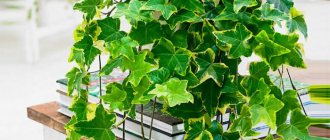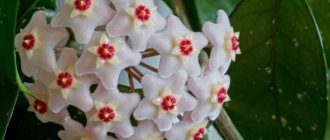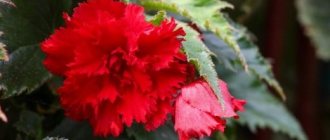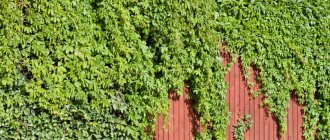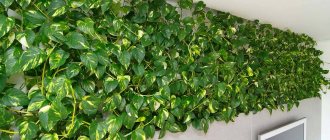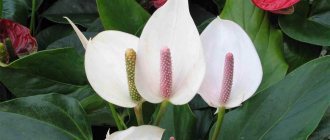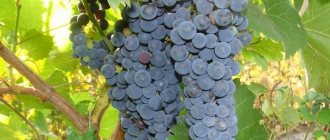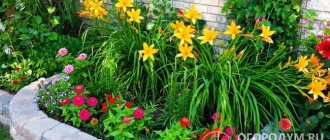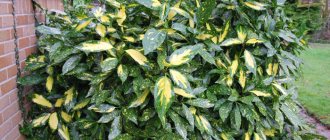Our distant ancestors also learned to grow ivy at home. This evergreen plant belongs to the Ampelaceae family, which has fascinatingly beautiful hanging vines. The flower is distinguished by thick, lush foliage, which gives a decorative appearance to the garden plot, an elite winter garden, creating coziness and aesthetics in the living room. It is readily chosen by dacha owners because the plant is unpretentious, care does not take much time, and it develops well on its own.
Popular types of ivy
Common ivy or Hedera, which means hanging plant, belongs to the Heder class. The homeland of lianas is the subtropics of the African continent. To make it easier for the plant to hold luxurious foliage, it easily entwines any support and is firmly held on it. This ability is used for decorative purposes, creating supports in different configurations or braiding a vine onto the walls of a building, fences, or gazebos.
If you control the development of ivy and provide appropriate care, it will help create an original, stylish interior. The main, commonly found types of ivy:
- the common loach quickly clings to everything that is nearby;
- the Lise variety is popular among gardeners due to the bright, unusual color of its large palmate leaves;
- Canary ivy is distinguished by variegated leaves of a dense structure.
Distribution in nature
The hedera's habitat is in areas with a warm and humid climate . In the wild, ivy is widespread throughout Eurasia. In Western European countries, the plant grows in floodplain and light forests. The branches climb the trees, sometimes entwining the trunk up to the crown. In the clearings you can find a carpet of creeping ivy. Thickets of the plant can be found in the Caucasus and Transcaucasia. Favorite places are beech forests, various thickets, and rocky slopes.
In Russia, ivy is not found in the wild ; it is cultivated as an evergreen “loach” to decorate parks, country and suburban areas, and public buildings. In addition, varieties have been developed that are suitable for growing indoors.
Proper ivy care
Despite its beauty, experts consider ivy to be a poisonous plant. Touching it with exposed skin can cause irritation and illness. In this regard, it is necessary to isolate children and living creatures from it, placing the flower away from them. Caring for it requires caution. Wearing gloves can prevent skin damage. In folk medicine it is used for medicinal purposes. Decoctions from the plant are useful for coughs, bronchitis, and asthma. After planting, ivy flowering can be observed after 10 years. When berries appear, they are removed.
In the summer, when temperatures are above 20°, the pot is switched to outdoor mode, where there is a lot of air and space. In winter, the room where the flower grows should be humid and cool, the norm for it is + 12 °C.
If ivy is kept indoors, it should be located in a place where its leaves will be protected from direct sunlight. The plant needs to be watered according to the season. In summer, the crop needs moderate but regular watering so that the soil always remains moist. Two waterings per week will be enough. In cold weather, the procedure should be carried out rarely, as needed.
Flower growing experts advise constantly maintaining humidity by spraying the plant. To do this, you can use a cool shower or soft, settled water. The decorative appearance of the leaves can be preserved by wiping with a regular soft cloth or buying a polish intended for flowers.
Sheet
The plant has three or five-lobed dark green leaves with a heart-shaped base . In mature plants they are more oval. The leaves are matte and attractive in appearance. They are located on a flexible stem very close to each other. this allows the heder to form a thick carpet.
Botanists distinguish 2 types of leaves . Dark green in color, large leathery leaves are formed on vegetative stems. Flowering branches have smaller leaf blades. Their shape is more oblong and elongated. The shade of the leaves is also different - they are colored a softer “grassy” green.
The appearance of the leaves may vary slightly among different plant varieties . Gardeners and professional landscape designers especially value leaves that have pronounced veins and are covered with white or cream spots. However, such varieties are distinguished by a more capricious disposition - they are more demanding in care and require longer daylight hours.
Reproduction and transplantation of ivy
Before planting indoor ivy, you need to prepare a mixture favorable for growth, which will include:
- 2 parts leaf humus;
- 2 parts turf soil;
- 1 - sifted sand.
The ivy pot must be selected in accordance with the requirements of sufficient width and shallow depth. Replanting should be done in the spring, when young root shoots break through the holes in the bottom. The first layer of drainage is placed in the flowerpot, then the prepared soil mixture is poured. The ivy plant, like any plant crop, needs feeding. The best option for fertilizing it is a mineral complex for indoor deciduous flowers. To prevent the leaves from growing too large under the influence of such procedures, you need to fertilize the soil in moderation.
The flower is propagated by various methods:
- shoots, immersing them in the ground located in the pot where the mother plant grows.
- cuttings, planting them at a thermometer reading of +23°.
- separation of ivy shoots, and subsequent rooting into the ground.
Causes and consequences of ivy disease
Ivy is susceptible to all the ailments characteristic of vegetation. It suffers from illnesses and suffers from attacks by pests, which have a detrimental effect on it, as on every indoor plant. When growing ivy, you can prevent diseases by knowing their causes and obvious signs. More often the plant suffers if:
- watering is carried out frequently, the leaves of the flower turn yellow and fall off;
- low humidity levels are allowed, the leaves become limp and dry;
- the room is not light enough, the leaves do not have enough light, they die;
- the plant is growing slowly - it’s time to fertilize the soil.
In the photo of ivy you can see how harmful insect pests affect the plant:
- thrips;
- scale insect;
- aphid;
- spider mite
If you plant and care for ivy responsibly, it will delight you for a long time with its magnificent decorative appearance, luxurious green palmate leaves, and their vibrant shine.
Interesting Facts
Ivy is one of the oldest decorative crops , as evidenced by its cultivation in Ancient Rome. One or another variety of it has been found on almost every continent.
Being an evergreen plant, ivy symbolizes immortality . However, this interpretation is not the only one. Ivy is also associated with fertility - it is not for nothing that it adorns the staff and wreath of the god Dionysius. Since ancient times, the image of a climbing plant has been decorated with cups and vessels for wine.
This vine is also a sign of faithful and devoted love . This is indicated by the legend of lovers Tristan and Isolde, on whose grave a grapevine and ivy grew and intertwined.
Ivy was also considered a plant that helps women maintain youth and beauty . It was included in wreaths and woven into hairstyles. It was believed that a twig placed on the chest of a sleeping girl would prolong her youth.
Such attention to the plant has led to the fact that it “appears” quite often in dream books . Seeing evergreen branches is a sign of success and health. For girls, such a dream promises pleasant meetings and unexpected surprises. Accordingly, dried ivy is a sign of illness and failure. It has been proven that the plant purifies the air and reduces the content of pathogenic microbes in it by 30-40%. That is why it is recommended to breed it in office and industrial premises, as well as at sites near factories, factories, and highways.
Hedera brings positive energy into the room . It is believed that it gives energy and strength, and self-confidence to indecisive people. However, when growing a plant at home, it is important not to forget that it is poisonous.
During the time of Avicenna, ivy gained even greater popularity, due to its medicinal properties . However, if you turn to ancient literature, you will find that with the help of evergreen leaves, Odysseus got rid of his wounds. In the Middle Ages, Leonardo da Vinci spoke about the healing properties of ivy.
Modern medicine for a long time did not recognize the medicinal properties of chedera , but recently its components have been used for traditional therapy (for example, “Prospan”, prescribed for bronchitis, cough) and in homeopathy. The plant has antitussive, antibacterial, anti-inflammatory and tonic properties, and heals wounds.
Lianas are also used in cosmetology - as a component of creams and other compositions to combat cellulite.
